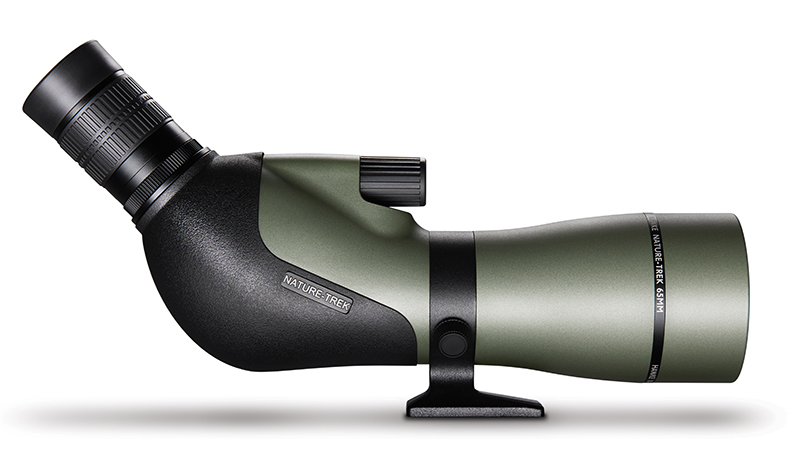Hawke Nature-Trek 16-48x65 telescope

Comprising just two models, Hawke’s Nature-Trek telescope range has been on the market since the beginning of the decade. As a result of the models’ recent upgrade, these ‘new’ scopes can be described as having a modern colour, as well as sporting a shorter, more compact chassis; the 20-60x80 model has also been made much lighter.
Another enhancement is the move away from a fixed tripod foot to one which rotates. The optical system has been tweaked, too, creating a much closer near-focus distance of 3.5 m, which make the two models Hawke’s closest-focusing telescopes.
Weighing just 1,130 g, I found the 65-mm model remarkably light. This weight includes the eyepiece, which is attached to the body through a simple screw-thread. The textured rubber covering extends over and adds protection to the rear and lower sections of the BAK-4 prism housing. The lens hood pulls out smoothly and easily.
When the thumb-screw is disengaged, the tripod foot rotates through approximately 225º and there are five very subtle, equally spaced click-in points in the turning arc, along which the screw can be used effectively at any point to secure the foot in any desired position.
When attaching the scope to a tripod head I discovered that, although the chassis alone is perfectly balanced, adding the eyepiece alters the centre of gravity and there is a tendency for the scope to tilt backwards when the head is not locked. This not is a major issue and it may not occur when the same eyepiece is used with the larger, 80-mm body.
The eyepiece has a generous, two-finger-deep, milled rubber grip for positive and precise magnification adjustment. It turns smoothly with ample resistance, providing a magnification range of 16-48x – or 20-60x when used with the 80-mm scope – with increments clearly marked for both models.
Focusing the telescope is achieved using a very smoothly turning, top-mounted focusing wheel. This is milled and chunky, providing plenty of grip, even when wearing gloves. It’s also very sensitive toward the highest end of the magnification range, and I must confess to having had difficulty in obtaining a satisfactorily sharp image beyond the 40x mark.
However, for a low-cost, 65-mm scope, the image was bright and sharp to the edge and I didn’t feel hemmed in by the field of view. Colour reproduction was largely good, although a little on the warm side with, for example, Phragmites reedbeds tending to reflect richer shades of straw rather than their natural, slightly lighter hues.
For a scope that does not use ED glass – although it does have a fully multi-coated optical system – I was surprised at how low the level of chromatic aberration appeared to be. It was virtually absent in the image’s centre and only really became noticeable in the outer 25 per cent or so. My overall assessment of the image – especially when the Nature-Trek’s price is taken into consideration – was very positive.
If I allow one further sliver of negativity to creep in I would have to mention that I don’t really like the somewhat old-fashioned fold-down rubber eye-cup. It is certainly not in keeping with the overall modern standard of the scope as a whole, and I wonder how much it would add to the cost to replace it with even a basic twist-out cup.
Nevertheless, this model still represents great value for the price and, although it is not marketed as a travel scope, its low weight enabled me to occasionally hand-hold it for stable viewing using the lower half of the magnification range without much difficulty.
The Nature-Trek comes complete with a removable tethered objective cover and a stay-on protective case. Compatible digiscoping adaptors with T2 rings are also available as optional extras.
Further info
- Suggested retail price: £229.99 (including zoom eyepiece)
- Size: 356x190 mm (including zoom eyepiece)
- Weight: 1,130 g (including zoom eyepiece)
- Field of view: 46-24.5 m at 1,000 m
- Light transmission: not available
- Close focus: 3.5 m
- Gas-filled: yes
- Waterproof: yes
- Warranty: 10 years
Verdict
- Image is bright and sharp – especially for a low-cost scope
- Chromatic abberation is very low for non-ED glass
- Fold-down rubber eye-cups look dated


